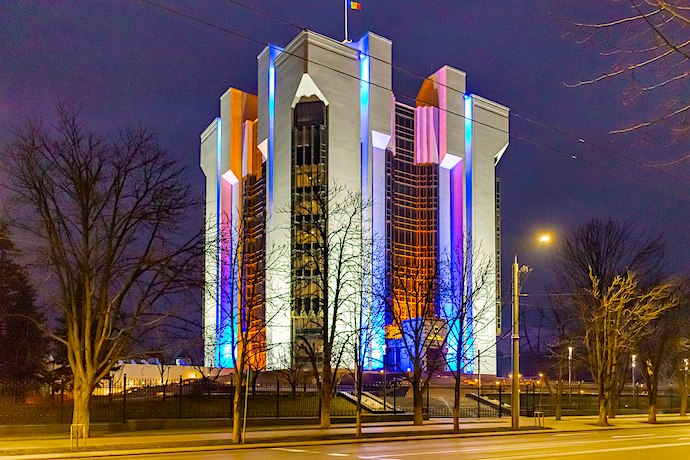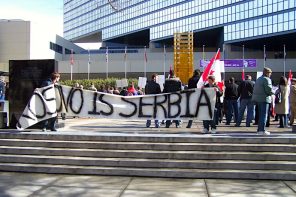I’m writing from Iași, Romania, which was the capital of the Principality of Moldova between 1564 and 1859 and the capital of Romania between 1916 and 1918, as well as the seat of the Romanian Orthodox Metropolitan of Moldavia and Bukovina. It’s also about 225 miles from the city of Tiraspol which is sort of in Moldova (more on that later), where, last week, explosions shook the Ministry of State Security and awakened fears that a new front might be opening in Russia’s campaign of aggression in its former sphere of influence.
There’s legitimate concern that if Moldova is the next country to come under Russian attack, Romania (a NATO member state) will, as a result of its close historical, cultural, and political ties to Moldova, be drawn into the conflict. This could, in turn, grant to Vladimir Putin his longed-for showdown with NATO and likely grant the rest of us a World War III.
It’s a rather unnerving thought as I sit here, looking out across the balcony of my rented flat at a gray sky and the glittering crosses that adorn the top of Iași’s imposing Metropolitan Cathedral.
Moldova was always among the three most likely places Putin would strike next, along with Estonia and the Republic of Georgia. All have breakaway regions with large Russian-speaking populations and historical ties to both the Russian Empire and the Soviet Union; and all are the site of complex jurisdictional conflicts between the Moscow-based Russian Orthodox Church (ROC) and local independent Orthodox bishops, usually acting with the support of the Patriarchate of Constantinople, a kind of ‘Rebel Alliance’ to the ROC’s ‘Empire’ (to borrow an unapologetically heavy-handed Star Wars metaphor).
The conflicts among Orthodox bishops in Moldova have received much less attention than similar conflicts in Ukraine, even from Orthodox media, but the situation bears some striking similarities. First, it’s important to remember that the territory that currently makes up Moldova has at various points been under Ottoman, Polish, Romanian, and Russian control.
In 1401, the autonomous Metropolis of Moldova was established by the Ecumenical Patriarch of Constantinople, with its seat in Iași. What is today eastern Romania and all of Moldova were under the Metropolis of Moldova until Bessarabia was annexed by the Russian Empire in 1812. Bessarabia, located in eastern Moldova, is the region that is currently under dispute. When this occurred, the Russian Orthodox Church took control of the churches and monasteries in the region and the local clergy came under the control of Moscow.
In 1918, in the wake of the Russian Revolution, the Russian Patriarch Tikhon gave the Moldovan Church the choice of uniting with either the Romanian Orthodox Church or the Russian Orthodox Church. The former was chosen.
However, when Moldova became independent in 1991 following the collapse of the Soviet Union, having seemingly forgotten the events of 1918, the Patriarchate of Moscow established the Metropolis of Chișinău and All Moldova, an autonomous but not independent jurisdiction. In the confounding structure of the Orthodox Church, this means that the metropolis has its own council of bishops (called a synod) but ROC has the final say over who the chief bishop is.
Just a year later, however, a group of clergymen, unhappy with the new metropolis—and, seemingly, its metropolitan—asked to join the Romanian Orthodox Church. This request was granted by the Patriarch of Romania, who established the Metropolis of Bessarabia. The Moldovan government initially resisted recognizing the new metropolis, but was forced to by the European Court of Human Rights following a lengthy legal battle.
Today, the Russian-aligned Metropolis of Chișinău and All Moldova remains the majority church by a large margin, but there’s little doubt that Metropolitan Petru of Bessarabia, the head of the Romanian-connected church, has used the Russian invasion of Ukraine to strengthen his position in a country rightly nervous about Russian hostility.
In his recent Easter message, Patriarch Petru declared that war is caused by “injustice, violence, disregard, lack of freedom and dignity, oppression and the desire to become more powerful than others.” This statement places him in direct opposition to Patriarch Kirill, not least by rejecting Kirill’s claim that the Russian fight was a “metaphysical battle” necessitated by evil forces, and by implicitly insisting that the war is the result of Russian oppression and power lust.
It’s a message that, in addition to being true, could very well have deep resonance with a Russia-leary Moldovan population. Meanwhile, Petru’s rival, Metropolitan Vladimir, the head of the Metropolis of Chișinău and All Moldova, made only oblique references to the current crisis in his Easter message, walking the thin line that so many Russia-aligned clerics outside of Russia walk these days.
I wrote for RD on the eve of the Russian invasion of Ukraine that any war between Russia and Ukraine would be a religious war. The same is true in Moldova (and would, for that matter, be true in Estonia and Georgia), because the current recurrence of Russian aggression is intimately linked to the intra-Orthodox conflict over liberalism and modernity that extends across the Orthodox world, that mirrors so much of what we saw within Islam, at the turn of the century.
The places in which the Orthodox Church is embroiled in ecclesiastical conflict are the hotspots in this battle including, one could argue, the United States. In turn, these are also regions of great importance in the global culture wars, pointing to the fact that the Christian East in general and Orthodox Christianity in particular have a unique and significant role to play in this emerging global struggle. A cultural zone long in the shadow of its Western brother to the Christian East, so long obsessed with its medieval past, has now been thrust, willingly or not, into the center of a very modern battle.
Sadly Ukraine is not the end of this battle. It is very likely just the beginning. And if the next chapter is Moldova there will be another set of Orthodox bishops’ names and allegiances to memorize and medieval and early modern history to take down from the shelves.





